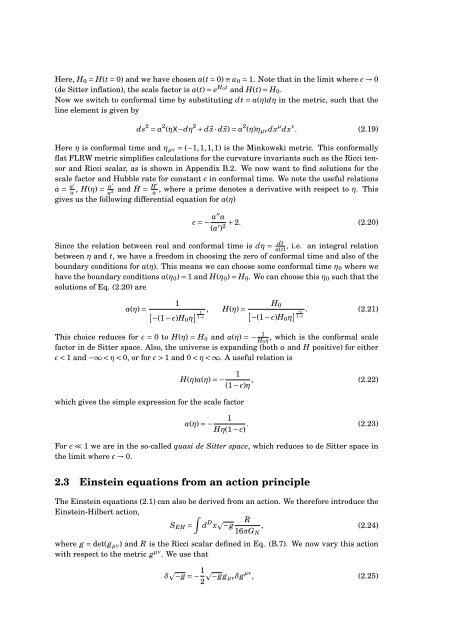Master's Thesis in Theoretical Physics - Universiteit Utrecht
Master's Thesis in Theoretical Physics - Universiteit Utrecht
Master's Thesis in Theoretical Physics - Universiteit Utrecht
Create successful ePaper yourself
Turn your PDF publications into a flip-book with our unique Google optimized e-Paper software.
Here, H 0 = H(t = 0) and we have chosen a(t = 0) ≡ a 0 = 1. Note that <strong>in</strong> the limit where ɛ → 0(de Sitter <strong>in</strong>flation), the scale factor is a(t) = e H 0t and H(t) = H 0 .Now we switch to conformal time by substitut<strong>in</strong>g dt = a(η)dη <strong>in</strong> the metric, such that thel<strong>in</strong>e element is given byds 2 = a 2 (η)(−dη 2 + d⃗x · d⃗x) = a 2 (η)η µν dx µ dx ν . (2.19)Here η is conformal time and η µν = (−1,1,1,1) is the M<strong>in</strong>kowski metric. This conformallyflat FLRW metric simplifies calculations for the curvature <strong>in</strong>variants such as the Ricci tensorand Ricci scalar, as is shown <strong>in</strong> Appendix B.2. We now want to f<strong>in</strong>d solutions for thescale factor and Hubble rate for constant ɛ <strong>in</strong> conformal time. We note the useful relationsȧ = a′a′a, H(η) = and Ḣ = H′a 2 a, where a prime denotes a derivative with respect to η. Thisgives us the follow<strong>in</strong>g differential equation for a(η)ɛ = − a′′ a(a ′ + 2. (2.20))2S<strong>in</strong>ce the relation between real and conformal time is dη = dta(t), i.e. an <strong>in</strong>tegral relationbetween η and t, we have a freedom <strong>in</strong> choos<strong>in</strong>g the zero of conformal time and also of theboundary conditions for a(η). This means we can choose some conformal time η 0 where wehave the boundary conditions a(η 0 ) = 1 and H(η 0 ) = H 0 . We can choose this η 0 such that thesolutions of Eq. (2.20) area(η) =1H 0[−(1 − ɛ)H0 η ] , H(η) =1[1−ɛ−(1 − ɛ)H0 η ] . (2.21)−ɛ1−ɛThis choice reduces for ɛ = 0 to H(η) = H 0 and a(η) = − 1H 0, which is the conformal scaleηfactor <strong>in</strong> de Sitter space. Also, the universe is expand<strong>in</strong>g (both a and H positive) for eitherɛ < 1 and −∞ < η < 0, or for ɛ > 1 and 0 < η < ∞. A useful relation iswhich gives the simple expression for the scale factor1H(η)a(η) = −(1 − ɛ)η , (2.22)1a(η) = −Hη(1 − ɛ) . (2.23)For ɛ ≪ 1 we are <strong>in</strong> the so-called quasi de Sitter space, which reduces to de Sitter space <strong>in</strong>the limit where ɛ → 0.2.3 E<strong>in</strong>ste<strong>in</strong> equations from an action pr<strong>in</strong>cipleThe E<strong>in</strong>ste<strong>in</strong> equations (2.1) can also be derived from an action. We therefore <strong>in</strong>troduce theE<strong>in</strong>ste<strong>in</strong>-Hilbert action,∫S EH = d D x R−g , (2.24)16πG Nwhere g = det(g µν ) and R is the Ricci scalar def<strong>in</strong>ed <strong>in</strong> Eq. (B.7). We now vary this actionwith respect to the metric g µν . We use thatδ −g = − 1 2−ggµν δg µν , (2.25)
















